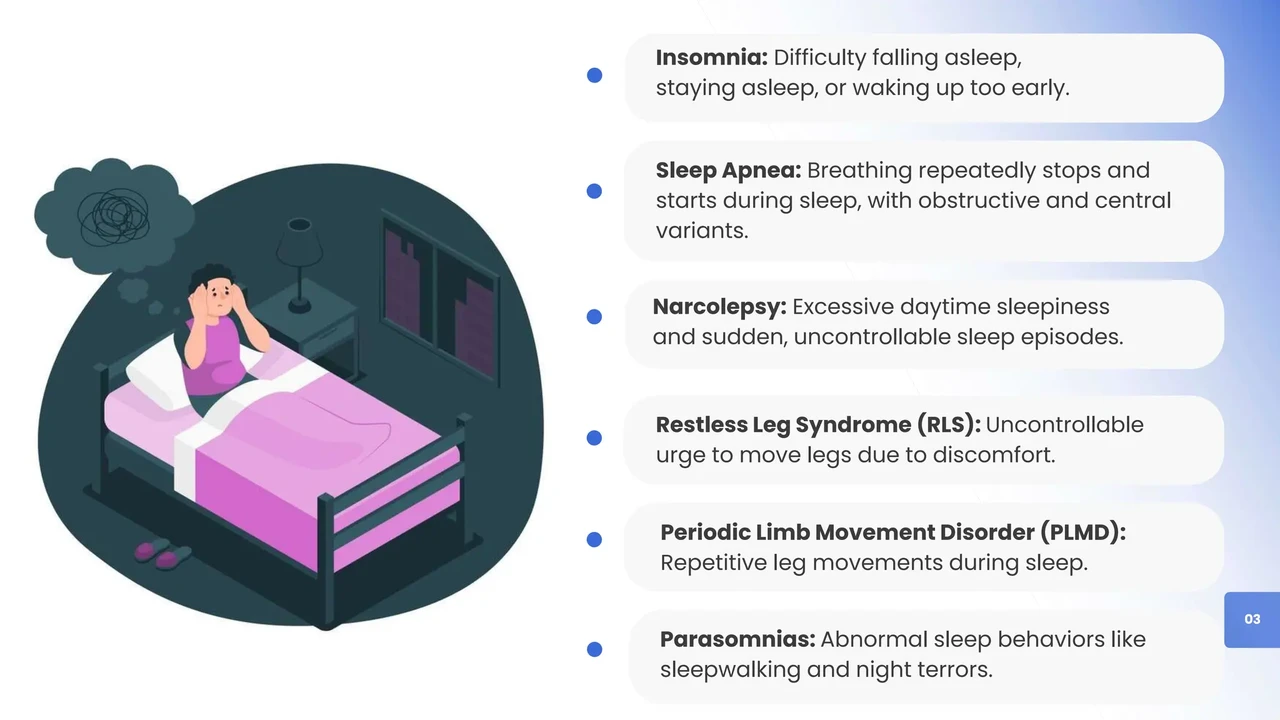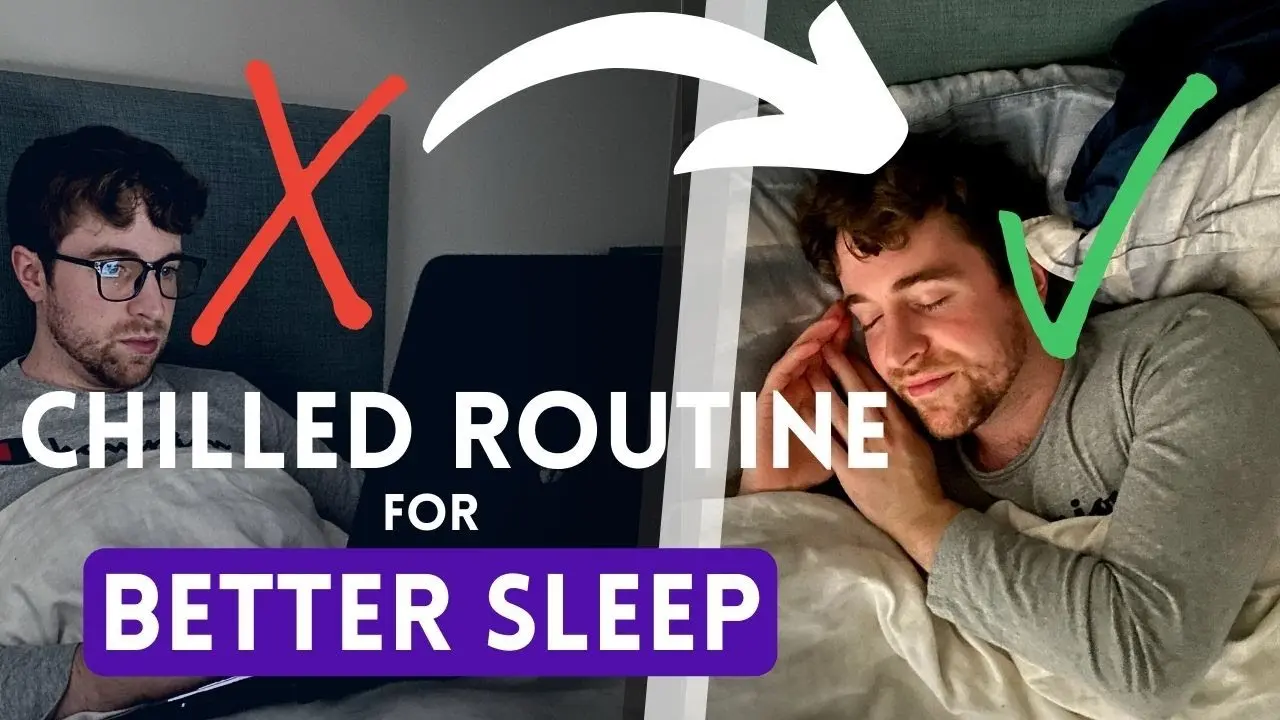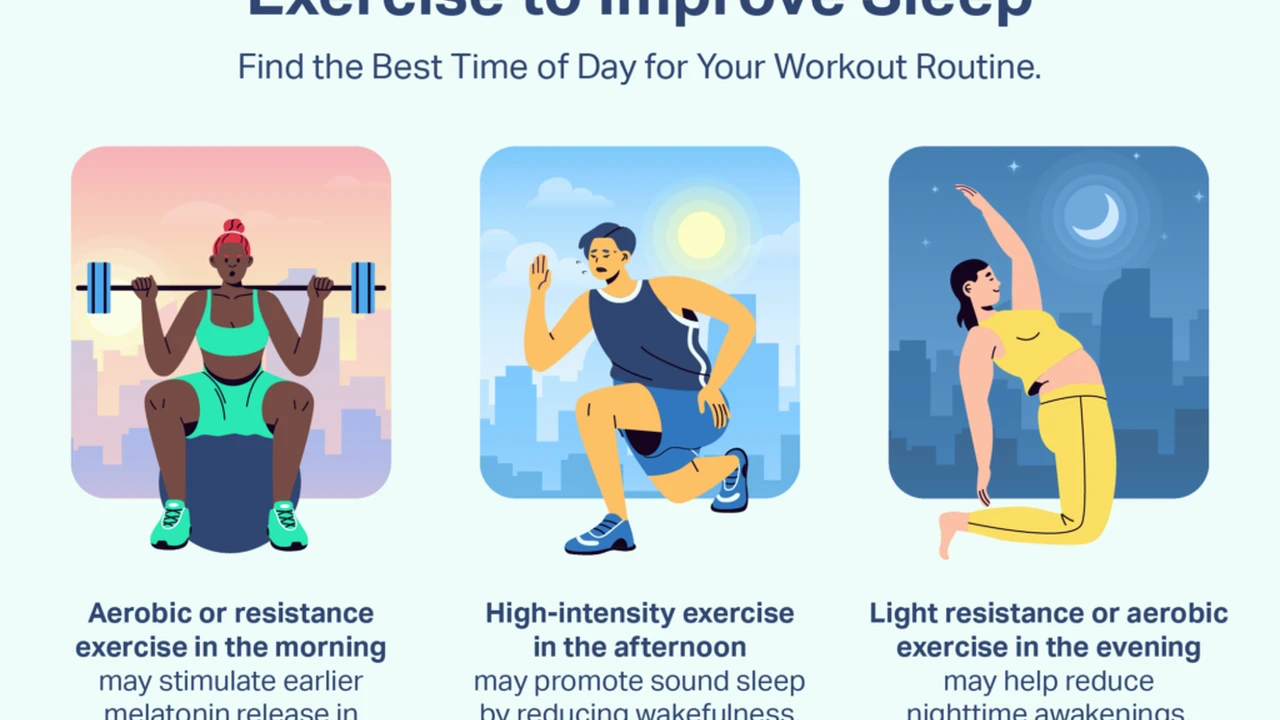5 Common Sleep Disorders Explained
Identify the five most prevalent sleep disorders and their symptoms. Understand the first steps towards diagnosis and treatment.

Identify the five most prevalent sleep disorders and their symptoms. Understand the first steps towards diagnosis and treatment.
5 Common Sleep Disorders Explained
Hey there, fellow sleep seekers! Ever feel like your nights are more of a battle than a blissful escape? You're not alone. Millions of people worldwide struggle with sleep, and often, it's due to underlying sleep disorders that go undiagnosed. Understanding what these common culprits are is the first step toward reclaiming your nights and boosting your overall health. We're going to dive deep into five of the most prevalent sleep disorders, break down their symptoms, and give you a roadmap for what to do if you suspect you might have one. Think of this as your friendly guide to navigating the sometimes-tricky world of sleep.
Understanding Insomnia Chronic Sleep Difficulty
Let's kick things off with the most common complaint: insomnia. We've all had those nights where sleep just won't come, but for someone with insomnia, this isn't an occasional annoyance; it's a persistent, frustrating reality. Insomnia isn't just about not being able to fall asleep; it can also mean waking up frequently during the night, waking up too early and not being able to get back to sleep, or simply not feeling refreshed after a full night's rest. It can be short-term (acute), often triggered by stress or life changes, or long-term (chronic), lasting for months or even years.
Insomnia Symptoms and Causes
So, what are the tell-tale signs? Beyond the obvious difficulty falling or staying asleep, you might experience daytime fatigue, irritability, difficulty concentrating, memory problems, and even increased errors or accidents. Chronic insomnia can seriously impact your quality of life, making daily tasks feel like monumental efforts.
What causes it? Oh, the list is long! Stress is a huge one, whether it's work-related, financial, or personal. Mental health conditions like anxiety and depression are also strongly linked to insomnia. Certain medications, caffeine, nicotine, and alcohol can all play a role. Poor sleep habits (like irregular sleep schedules or using electronics in bed) are major contributors. Medical conditions such as chronic pain, restless legs syndrome, or even acid reflux can also keep you awake. Sometimes, it's a combination of factors, making it a bit of a puzzle to solve.
Insomnia Treatment Options and Products
The good news is, insomnia is highly treatable! The first line of defense is often Cognitive Behavioral Therapy for Insomnia (CBT-I). This isn't just talk therapy; it's a structured program that helps you identify and replace thoughts and behaviors that prevent you from sleeping well. It's super effective and often recommended over medication for long-term results.
When it comes to products, while there's no magic pill, some things can help create a better sleep environment or aid relaxation:
- Weighted Blankets: These can provide a sense of calm and security, often described as a comforting hug. Brands like Gravity Blanket (around $150-$250 USD) or more affordable options like YnM Weighted Blanket (around $50-$100 USD) are popular. They work by applying deep pressure stimulation, which can reduce anxiety.
- Sound Machines: White noise, pink noise, or nature sounds can mask disruptive noises and create a consistent auditory environment. The Hatch Restore (around $130 USD) is a popular all-in-one device that combines a sound machine, smart light, and alarm. For a simpler, more budget-friendly option, the LectroFan Classic (around $50 USD) is a solid choice.
- Aromatherapy Diffusers: Essential oils like lavender, chamomile, or bergamot can promote relaxation. The ASAKUKI 500ml Essential Oil Diffuser (around $30-$40 USD) is a good mid-range option, often bundled with essential oil sets.
Medications can be used for short-term relief, but they're generally not a long-term solution due to potential side effects and dependency. Always consult a doctor before starting any sleep medication.
Sleep Apnea Breathing Interruptions During Sleep
Next up, sleep apnea. This one is serious because it involves repeated pauses in breathing during sleep. Imagine your body briefly suffocating multiple times a night – that's what happens with sleep apnea. The most common type is Obstructive Sleep Apnea (OSA), where the airway collapses or becomes blocked. Central Sleep Apnea (CSA) is less common and occurs when the brain fails to send proper signals to the muscles that control breathing.
Sleep Apnea Symptoms and Health Risks
The hallmark symptom is loud, chronic snoring, often punctuated by gasps or choking sounds. Your bed partner might be the first to notice this! Other symptoms include excessive daytime sleepiness, morning headaches, irritability, difficulty concentrating, and dry mouth or sore throat upon waking. Because breathing stops, your body briefly wakes up to restart breathing, often without you realizing it, leading to fragmented, non-restorative sleep.
The health risks are significant. Untreated sleep apnea can lead to high blood pressure, heart attack, stroke, diabetes, and even increased risk of accidents due to daytime fatigue. It's not just about snoring; it's about your heart and brain health.
Sleep Apnea Diagnosis and Treatment Devices
If you suspect sleep apnea, a sleep study (polysomnography) is crucial. This can be done in a sleep lab or sometimes at home. It monitors your breathing, heart rate, oxygen levels, and brain activity during sleep.
The primary treatment for OSA is a Continuous Positive Airway Pressure (CPAP) machine. This device delivers a continuous stream of air through a mask worn over your nose or mouth, keeping your airway open. It's a game-changer for many!
- CPAP Machines: Leading brands include ResMed AirSense 10 AutoSet (around $800-$1200 USD, often covered by insurance) and Philips Respironics DreamStation Auto CPAP (similar price range). These are prescription devices, so you'll need a doctor's referral. They come with various mask types (nasal pillows, nasal masks, full-face masks) to suit individual comfort.
- Oral Appliances: For mild to moderate OSA, a custom-fitted oral appliance (like a mandibular advancement device) can be worn at night to reposition the jaw and tongue, keeping the airway open. These are typically fitted by a dentist specializing in sleep medicine and can range from $1,500-$3,000 USD.
- Positional Therapy Devices: Some people only have apnea when sleeping on their back. Devices like the Night Shift Sleep Positioner (around $300-$400 USD) vibrate to encourage you to change positions.
Lifestyle changes like weight loss, avoiding alcohol before bed, and sleeping on your side can also help.
Restless Legs Syndrome RLS Uncontrollable Leg Sensations
Imagine an irresistible urge to move your legs, often accompanied by uncomfortable sensations like crawling, tingling, aching, or itching. These sensations typically worsen in the evening or night, especially when you're resting or inactive. That's Restless Legs Syndrome (RLS), also known as Willis-Ekbom Disease.
RLS Symptoms and Triggers
The primary symptom is that overwhelming urge to move your legs, which is temporarily relieved by movement. It can make falling asleep incredibly difficult and often wakes people up during the night. The sensations are usually in the calves, thighs, or feet, but can sometimes affect the arms. They tend to be worse at night and can be triggered by prolonged periods of inactivity, like sitting on a long flight or in a movie theater.
While the exact cause isn't fully understood, it's thought to involve an imbalance of dopamine in the brain, which controls muscle movement. It can also be genetic, run in families, or be associated with conditions like iron deficiency, kidney failure, pregnancy, or certain medications (antidepressants, antihistamines).
RLS Management and Comfort Products
Treatment for RLS often focuses on managing symptoms. If an underlying condition like iron deficiency is found, treating that can resolve the RLS. Otherwise, lifestyle changes and sometimes medication are used.
- Iron Supplements: If iron deficiency is identified, your doctor might prescribe iron supplements. Brands like Nature Made Iron or Garden of Life Vitamin Code Raw Iron are widely available (around $10-$20 USD).
- Compression Socks/Wraps: Some individuals find relief from mild compression. While not a cure, products like Comrad Compression Socks (around $20-$30 USD) or simple athletic compression sleeves can offer comfort.
- Magnesium Supplements: While scientific evidence is mixed, many people report relief from magnesium. Nature Made Magnesium Oxide or NOW Foods Magnesium Citrate (around $10-$25 USD) are common choices. Always consult your doctor before taking supplements.
- Topical Creams: Some people use topical magnesium creams or pain-relieving balms like Biofreeze (around $10-$20 USD) for temporary relief of sensations.
Medications that increase dopamine in the brain (like those used for Parkinson's disease) are often prescribed for more severe cases. Regular exercise, avoiding caffeine and alcohol, and maintaining a consistent sleep schedule can also help.
Narcolepsy Excessive Daytime Sleepiness
Narcolepsy is a chronic neurological condition characterized by overwhelming daytime sleepiness and sudden attacks of sleep. It's not just being tired; it's an uncontrollable urge to sleep, often at inappropriate times, even after a full night's rest.
Narcolepsy Symptoms and Impact
The primary symptom is excessive daytime sleepiness (EDS), which can be debilitating. People with narcolepsy might fall asleep while talking, eating, or driving. Another classic symptom is cataplexy, a sudden loss of muscle tone triggered by strong emotions like laughter, anger, or surprise. This can range from slight weakness (like drooping eyelids) to complete body collapse. Other symptoms include sleep paralysis (being unable to move or speak when falling asleep or waking up) and vivid, dream-like hallucinations.
Narcolepsy significantly impacts daily life, affecting work, school, relationships, and safety. It can be isolating and lead to misunderstandings from others who might perceive the person as lazy or unmotivated.
Narcolepsy Management and Lifestyle Aids
There's no cure for narcolepsy, but treatments can help manage the symptoms. Diagnosis usually involves a sleep study and a Multiple Sleep Latency Test (MSLT), which measures how quickly you fall asleep during the day.
Medications like stimulants (to promote wakefulness) and antidepressants (to manage cataplexy) are commonly prescribed. Beyond medication, lifestyle adjustments are key:
- Scheduled Naps: Short, strategic naps (15-20 minutes) throughout the day can help manage EDS. While not a product, setting reliable alarms on a smartwatch like the Apple Watch SE (around $250-$300 USD) or Fitbit Sense 2 (around $200-$250 USD) can be helpful for consistent timing.
- Light Therapy Lamps: While primarily used for Seasonal Affective Disorder, some individuals with narcolepsy find bright light therapy in the morning helps regulate their sleep-wake cycle. The Philips SmartSleep Wake-up Light (around $100-$150 USD) or the Verilux HappyLight Full Spectrum Light Therapy Lamp (around $50-$70 USD) are popular options.
- Caffeine: Used cautiously, caffeine can help with alertness, but it's not a substitute for prescribed medication.
Maintaining a regular sleep schedule, avoiding heavy meals before bed, and informing employers/schools about the condition are also important strategies.
Bruxism Teeth Grinding During Sleep
Finally, let's talk about bruxism. This is the medical term for grinding, clenching, or gnashing your teeth, often unconsciously, especially during sleep. While some people do it during the day, nighttime bruxism is more common and can be more damaging because you're unaware of it.
Bruxism Symptoms and Consequences
The most common signs are a dull, constant headache, a sore jaw, or facial pain upon waking. Your bed partner might also complain about the grinding noises. Over time, bruxism can lead to worn-down teeth, chipped teeth, increased tooth sensitivity, damaged dental restorations (fillings, crowns), and even temporomandibular joint (TMJ) disorders, causing pain and difficulty moving your jaw.
Stress and anxiety are major culprits, as are certain medications (like some antidepressants), caffeine, alcohol, and smoking. Sleep disorders like sleep apnea can also be linked to bruxism.
Bruxism Protection and Relief Products
The primary goal of bruxism treatment is to protect your teeth and alleviate symptoms. Your dentist is your best friend here!
- Night Guards (Occlusal Splints): These are custom-fitted mouthguards worn at night to create a barrier between your upper and lower teeth, preventing grinding and clenching. A custom-made guard from your dentist is the most effective (ranging from $300-$800 USD, sometimes covered by dental insurance). Over-the-counter boil-and-bite mouthguards like DenTek Comfort-Fit Dental Guard (around $15-$25 USD) or SleepRight Dental Guard (around $20-$30 USD) are more affordable alternatives, but they might not fit as well or offer as much protection as a custom one.
- Stress Reduction Tools: Since stress is a big factor, anything that helps you relax can indirectly help. This could be meditation apps like Calm or Headspace (subscription fees apply, around $70 USD/year), or even simple stress balls.
- Warm Compresses: Applying a warm, moist cloth to your jaw can help relax the muscles and alleviate soreness.
Your dentist might also recommend dental corrections if teeth are misaligned, or suggest muscle relaxants for short-term relief of jaw pain. Addressing underlying stress or anxiety is also crucial for long-term management.
When to Seek Professional Help for Sleep Issues
So, you've read through these common sleep disorders, and maybe a few things resonated with you. The most important takeaway is this: if you're consistently struggling with sleep, or if your sleep issues are impacting your daytime functioning and overall health, it's time to talk to a professional. Don't just brush it off as 'normal' or 'just stress.' A primary care doctor is a great first step; they can assess your symptoms, rule out any obvious causes, and refer you to a sleep specialist if needed. A sleep specialist, often a neurologist or pulmonologist with specialized training, can conduct sleep studies and provide a definitive diagnosis and tailored treatment plan. Reclaiming your sleep is an investment in your health, happiness, and productivity. Sweet dreams!
:max_bytes(150000):strip_icc()/277019-baked-pork-chops-with-cream-of-mushroom-soup-DDMFS-beauty-4x3-BG-7505-5762b731cf30447d9cbbbbbf387beafa.jpg)




